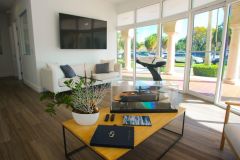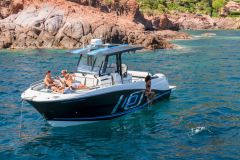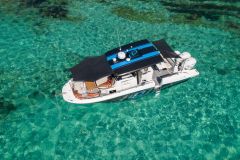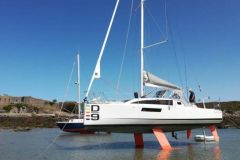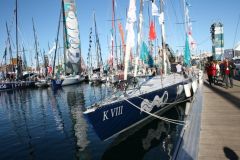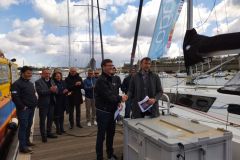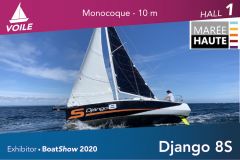"We wanted people to find the DNA racing off the High Tide yard."
It is with these words of Éric Brulé, the co-leader of Marée Haute, that the visit of the Django 8 S begins. Indeed, about fifteen years ago, the Tregunc shipyard became known with the production of Mini6.50 before extending their range to fast cruising boats.
The site, which has been working for a long time with architect Pierre Rolland, has developed a range of 5 Django from 5.50 m to 12.70 m. In 2019, the Django 8S integrates the range and positions itself as a large mini ready to be aligned with offshore regattas.

A small boat boosted for the open sea
This time, Tide High wishes to be famous on IRC offshore races such as the Transquadra, the Armen Race or the Fasnet. The growing popularity of these regattas attracts many builders - both young and old - who are fighting each other mercilessly to win in this new racing format.
These regattas often require the boat to be certified in category A. The constraints associated with this certification are becoming increasingly difficult to obtain for small light sailboats. But the High Tide shipyard is fortunate to have in its range the Django 7.70 which obtained category A status 10 years ago when it was certified.
Thus the manufacturer "diverted" the hull of the Django 7.70 to boost it and familiarize himself with the limits of the acceptable rating for Transquadra type races.

A cockpit optimized by performance
When you arrive on the Django 8S, the first impression is in line with the spirit of the boat: to be able to sail efficiently with a reduced crew.
And for good reason, it was the figaro player Gildas Mahé who was consulted for the optimization of the manoeuvres. The cockpit is articulated around a steering station and a manoeuvring station. The helmsman will have a comfortable position with the GV settings and the listening winch within easy reach. When manoeuvring, all halyards and fine adjustments on either side of the bonnet will be used.
At the bottom of the cockpit is the liferaft. It is housed in a disbursement, the location is judiciously chosen both for accessibility and weight distribution.

A modern and efficient rigging
For the rigging, the yard also consulted the runner Gildas Mahé. He directed High Tide towards a carbon spar with a "cathedral" type guying with a single storey of pushing spreaders.
On the boat visited, the 29 m2 mainsail with horn is completed by a solent (21 m2) with reef mounted on a carabiner, which is relevant for the offshore sailing programme.
A carbon delphinière laminated to the hull, brings the total length to 8.60 m and allows to rig a code 0 or an asymmetric spinnaker. But the symmetrical spinnaker and its spinnaker pole are also on board in order to ensure a satisfactory descent in the downwind direction.

Movement on deck is somewhat hampered by the lower shrouds on the planks, but it is also a guarantee of good rigging performance. The rigging screws return to the liston which will allow those who wish to do so to play on the curvature of the mast and the general tension.
The roof has a strong personality. A part of it is in whistle, but another part integrates frontal portholes like many contemporary messengers. This roof has the advantage of offering a view of the sails when you are inside.

A minimalist layout
The discovery of the interior gives a first impression of functionality. In accordance with the sailing program, which imposes lightness as a key word, the interior layout is very minimalist.
The finish is rough, but clean. The draping of the fabrics is visible as in the latest Sun Fast or Figaro Bénéteau. We can see that the sealant has lost the war of superfluous weights.
At the bottom of the forepeak, we can see the crash box. As you turn around, you discover a watertight aft bulkhead that separates the jaumière tubes from the rest of the sailboat. Flotation volumes are distributed in the boat.

An open and organized volume for performance
The chart table, hung on the mast sponge, breaks the pleasant impression of volume, it is likely to disappear quickly. The saloon seats and the forward cabin are equipped with anti-roll cloths.
Still in the square, there are many mattress spaces to distribute the weights as well as possible. In the back bunk, there is no mattress cloth, it's a shame. However, teams running along the planks will be used to check the water packs.
In the centre of the saloon, the small table allows two people to eat comfortably (this is the boat's programme) and occasionally four people. The square is organized in such a way as to offer an easy matossing, we feel that the sailors have given their specifications.
To starboard of the descent is the lazarette equipped with a double stove and a sink. On the port side, an empty space is still available to accommodate a possible ball cushion dear to offshore runners for a short rest. It is also where the small electrical panel is located.
The engine chock is accessible enough for routine maintenance.





